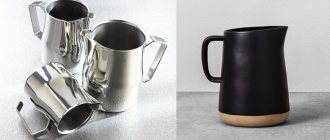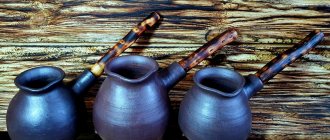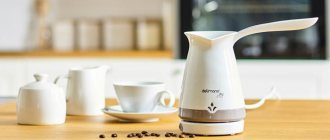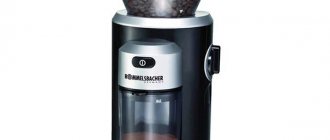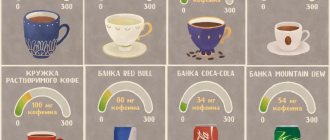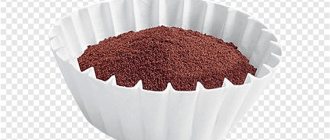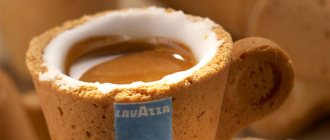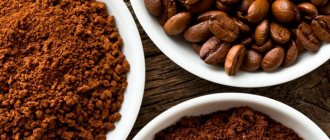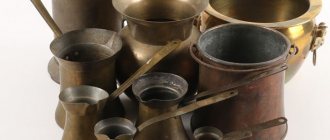Form
Sergey Blinnikov, Russian bronze medalist in preparing coffee in a cezve:
“I hope that somewhere there is a wonderful world in which everyone has the opportunity to buy the perfect cezve: solid, hand-forged, made of pure silver, with thick walls, correct geometry and a bronze handle. In our world, such a thing exists, but it costs $800. So let's look at more realistic options.
The most important thing in a cezve is its geometry, in particular the ratio of the width of the base to the width of the neck. The narrowing should be small but visible, about 20% of the bottom size.
If the neck is too narrow, the coffee tablet that forms during brewing will be too thick and only the coffee that comes into contact with the liquid will be extracted. The top of the tablet may even remain dry.
If the neck is too wide or does not exist at all, then a coffee tablet will not form on the surface. The coffee will boil uncontrollably and overbrew. If you have such a cezve, I advise you to use it for boiling eggs - it’s very convenient.”
Options for choosing Turks for coffee
Volume
When talking about the volume of the cezve, one must not miss the rule: less is better than more. Only small size Turks, up to 100 ml, are able to fully preserve the aroma and, accordingly, the taste of the drink.
The increased size of the product will save time so as not to cook a portion for each guest separately, but the quality of the finished product in this case will decrease. This is due to the fact that small cezves have a narrow bell.
Form
Almost every coffee lover knows that Turkish coffee has its own special shape. It is barrel-shaped, squat, tapering upward, visually very reminiscent of a jug. This form was chosen for a reason; it is solely thanks to it that it is possible to achieve the preparation of coffee with the desired consistency, unique taste and rich aroma.
In a narrow bell, a layer of foam is formed, which is so valued by gourmets. It is best that the neck be funnel-shaped, then it will be more difficult for the coffee to “escape”. Sloping sides will allow sediment to settle better, while steep sides will add greater aesthetics. The bottom of the cezve should be wide so that heating occurs quickly and evenly.
Bottom
Ideally, the bottom of the Turk should be three or four times the width of the socket.
1. This promotes the formation of thick and rich coffee foam.
2. Heating is carried out in a shorter time than with cookware with a narrow bottom.
Pen
A pen is required. It must be firmly attached to the bowl of the cezve. In this case, be sure to take into account that there is a special coating that will not conduct heat. This is the only way to avoid injury in the form of a burn. It can be a rubberized part or plastic or wood.
Wooden handles look more presentable, especially when they are made in an interesting and unusual antique style. Before purchasing, we recommend holding the Turk by the handle to make sure you are comfortable. Removable handles on Turks make them more mobile and also simplify washing.
Size
Maria Trokhimenko, judge of Russian barista championships and champion of the Far East in cezve coffee:
“Choose a cezve according to the standard size of your cup, for example, 200 or 250 ml. You can also have a very small one, 90 ml, like in Turkish cafes. This volume will cook faster due to less water.
You can, of course, take a 500 ml Turk to prepare several cups at once. But all the brewed coffee needs to be drunk at once. It will not be possible to make a small portion in a large Turk: as in the case of a Turkish Turk that is too wide, the coffee head will not form and the coffee will boil quickly.”
Operating principle and design of coffee turks
Turk (cezve) is one of the most common types of traditional utensils for brewing coffee. It was invented hundreds of years ago, in the East. The classic Turk consists of a bowl with a narrow bell, a wide bottom and a handle. This form is classic, but modern products offer alternative solutions.
The Turk works, like any other cookware, due to heating and heat transfer. The required portion of coffee powder is poured into the bowl and water is added. After this, the cezve is placed on the gas. The cooking process takes on average 10-15 minutes. Thanks to the design features, very little evaporation is ensured, and this allows the drink not to thicken too much.
The wide bottom is responsible for quick heating of the entire product. The jug-shaped shape of Turka helps the resulting thickening to settle quickly. After removing from the heat, you need to let the drink sit for 5-10 minutes, after which you can start pouring into cups. The handle is necessary for convenience, so that you can easily hold and carry a hot cezve.
Material
Sergei Blinnikov:
“The best choice, besides silver, is copper. It conducts heat well, but does not accumulate it, so it is easy to control the process of making coffee in such a cezve, especially if its walls are thick, about 1.5 mm. It is important that the copper is internally treated with silver or food-grade tin - a material that does not enter into chemical reactions with food. But tin and silver are easily erased, so you need to wash Turks with such a coating very carefully, with your hands and water, without sponges or detergents.
The most famous silver-plated copper Turks are Soy. Participants in cezve championships most often choose them.
If you're neat, consider purchasing a quartz cezve. It shows everything that happens to coffee during the brewing process, it’s fascinating.
Ceramic cezves are quite capricious. They transfer heat unevenly and tend to accumulate it. Coffee can run away when you have already removed the Turk from the heat.”
Maria Trokhimenko:
“Clay absorbs coffee oils, so it can change the taste of coffee. It will not be possible to prepare the same drink in a clay pot two times in a row.
Don't buy an aluminum pot. When heated, aluminum reacts with the drink, changes its taste and is generally considered unsuitable for cookware.
In a stainless steel pot you can achieve relatively good results. But there is a minus - low thermal conductivity. A stainless steel pot heats up unevenly, like a saucepan, and will overheat the coffee in the bottom area. There is a risk that the drink will turn out more bitter.”
The best manufacturers of Turks for coffee - which company to choose
Very often, Turks are made not only in large-scale production, but also by craftsmen in a single copy. Such models of cezves are distinguished by an unusual design and have beautiful patterns that decorate the outer part of the dishes. They cost more than options for mass sales. Lovers of the black drink prefer to purchase Turkish coffee from Eastern companies, since that is where they were once invented.
If you do not have the opportunity to purchase an exclusive Turk, and also do not want to go deeper into the material, then check out our list of the most popular companies:
- Vitesse;
- Becker;
- TimA;
- Regent;
- Stanitsa.
All represented companies manufacture products from high-quality materials, which makes the products reliable. Many models have beautiful paintings reminiscent of antique ones. Turks are made from a variety of materials, which gives the consumer a good choice. For those looking for a specific model, we advise you to go directly to our rating of the best Turks.
Recommendations: 20 Best French Presses
To dust or not to dust, that is the question
Sergei Blinnikov:
“Thanks to the grounds, coffee from the cezve continues to be extracted in the cup until it is completely drunk. This is both good and bad: with the right recipe and grinding, the drink will open up better and better every minute!
But there is a problem: with such a long extraction, up to 20-30 minutes, there is a great danger of overbrewing the coffee and getting extra bitterness in the taste. This needs to be taken into account when choosing the grind.
Choose according to the principle “the darker, the larger.” For example, I brewed Yemen Matari No. 4 (light roast), Brazil Irmas Pereira 36 Hour Fermentation No. 170 (medium roast, dark filter), and Honduras San Marcos No. 22 (darker than medium roast). All beans gave off enough sweetness with a coffee to water ratio of 1:8-1:9 (12 g of coffee per 100 ml of water). But Yemen opened up with an espresso grind, and for Honduras we had to take a grind that would be suitable for a Chemex. Unfortunately, with such a coarse grind, the coffee loses its body, but we remove excess bitterness from the drink. Although when brewing group B it is not possible to completely avoid bitterness - this is a dark roast.
If you don’t like grounds in your cup, filter the cezve using paper filters. The V60 funnel or AeroPress will give you a clean drink. But the thicker the layer of paper, the lighter the cup you will get.”
Comparison of ceramic and copper vessels
Environmentally friendly
It is quite rare to find a ceramic Turk. It is made from clay mixed with various plasticizers. Ceramic vessels are always more expensive. Depending on the manufacturer, the price of copper and ceramic products sometimes varies by four times.
Let's compare which Turk is better for cooking - copper or ceramic.
When exposed to high temperatures, ceramic products do not emit hazardous substances like copper products. Ceramic cookware will last longer if it doesn't break. It is fragile and not resistant to mechanical damage. Thick clay walls ensure slow heating of the mass.
The complexities of a unique product
If we compare copper with ceramics, handmade clay vessels cannot be made exactly the same. Each of them is unique. But the complex decor makes it difficult to care for the product; as a result, such dishes are often displayed on a shelf at home and are not used.
If the surface of a clay product is not covered with glaze, then large pores quickly absorb coloring pigments and foreign odors. For copper Turks, the advantage is its cone-shaped shape. Ceramic containers are chosen by people for whom environmental friendliness comes first.
Spices in Turk
Sergei Blinnikov:
“If you're tired of regular coffee, don't be afraid to experiment with additives and spices. You probably have everything at home to make a cool signature drink. For example, I took second place in the championship with a recipe that used star anise, saffron and canned peaches.
The main thing is to follow the order in which the ingredients are added. Always add coffee to the bottom of the cezve. Add bulk ingredients – sugar, spices – to the ground grain. Part of the water (but not more than half) can be replaced with almost any juice; pour it over ground coffee. And only at the end add water and put on fire.
Do not use more than three ingredients, otherwise you risk losing the taste of the coffee. If you add something sour, balance it with something sweet. I do not recommend salt, black pepper and cinnamon - they kill the taste of the cezve.
Experiment, and let each new cup be a small discovery!
More on the topic: “How to improve the taste of coffee in a cezve”
Volume of Turks: from one serving to a large group
For yourself and a friend
There are cezves of all sizes on sale, so you need to decide exactly which Turk to buy. To get delicious coffee, it is important to fill the vessel with a certain precision. The contents are consumed immediately. That is why it is recommended to purchase a product whose volume is enough for one brew.
If you need one serving of coffee, we recommend an individual, that is, a small container volume of 100 to 150 ml. After cooking, you get one cup.
The most popular and universal volume of Turka is 250-350 ml. It holds two cups of aromatic drink. This is a popular option.
For guests
A 500 ml cezve is the best choice for a family in which three or four people drink natural coffee at the same time. This is the best option for a small number of guests.
The 750 ml Turka is suitable for family celebrations and large groups, when 7-8 people are treated to a drink at once. Stainless steel cookware is suitable, which is produced only industrially and only in large volumes - from 500 ml (rarely 400 ml) to 750 ml.
Classic cezve recipe from Maria Trokhimenko
Maria uses a Soy copper cezve.
What you will need:
- 115 g water at room temperature;
- 11 g coffee;
- grind – fine espresso;
- cooking time 2.5 min.
How to cook:
Add coffee, pour water, turn on the timer. Put the Turk on gas and stir the coffee well to break up all the lumps. This is convenient to do with a thin wooden stick.
Control the brewing time by adjusting the heat level. As soon as the coffee cap rises to the edge of the cezve, the coffee is ready. Pour it into a cup and let it breathe for another two minutes.
Comfortable handle for easy cooking
Reliability is ensured by bolts
Before purchasing a cezve, pay attention to the material and method of attaching the handle. This affects comfort and safety during cooking.
The handle must be attached to the product with bolts - this is the most acceptable option. Soldered holders are not as reliable. This is explained by the fact that the Turks often coat them with compounds that prevent the oxidation of the metal, but impair the quality of soldering. Such a handle will simply fall off at any moment.
Features of materials
Metal handles are traditionally found on cheap products. Such parts heat up quickly, so you will have to constantly use an oven mitt.
Wooden handles do not heat up, they are beautiful and environmentally friendly, but as a result of frequent washing they quickly lose their neat appearance. Used for vessels made of copper and ceramics.
Bakelite has been especially popular lately - it is a type of plastic that is lightweight and cannot be heated or melted. Most often, such holders can be found on glass and steel products.
Helpful Tips and Reminders
Based on the above, we can draw a conclusion about how to choose a Turk for coffee.
This must be done responsibly and carefully; there are many options. The best choice for gourmets would be a copper vessel of rich color, and for people who prefer environmentally friendly materials - a ceramic one.
The fewer decorative elements on a product, the better. It’s good if there is a removable, non-heating handle - it will be easier to wash the container.
Do not use abrasive or aggressive substances for cleaning, otherwise the coffee will absorb their smell. After using it at home, rinse the vessel with hot water while wiping it with a sponge.
In general, which Turk is better to brew coffee in is an individual choice.
Interesting! How to brew coffee with milk in Turkish
Electric Turk as an alternative
If you do not have access to a stove, use an alternative option - an electric cezve. In this case, the taste and aroma of the treat will not be rich and bright, but this is compensated by the speed of preparation.
There are two types of electric Turks: with or without an auto-shut-off function. A device without automatic shut-off is similar to a miniature electric kettle. The device is placed on a heating base that has a built-in sensor. At the moment the drink boils, the electric cezve is removed from the platform or disconnected from the network.
More details about such vessels are written in the article “What is an electric Turk”.
